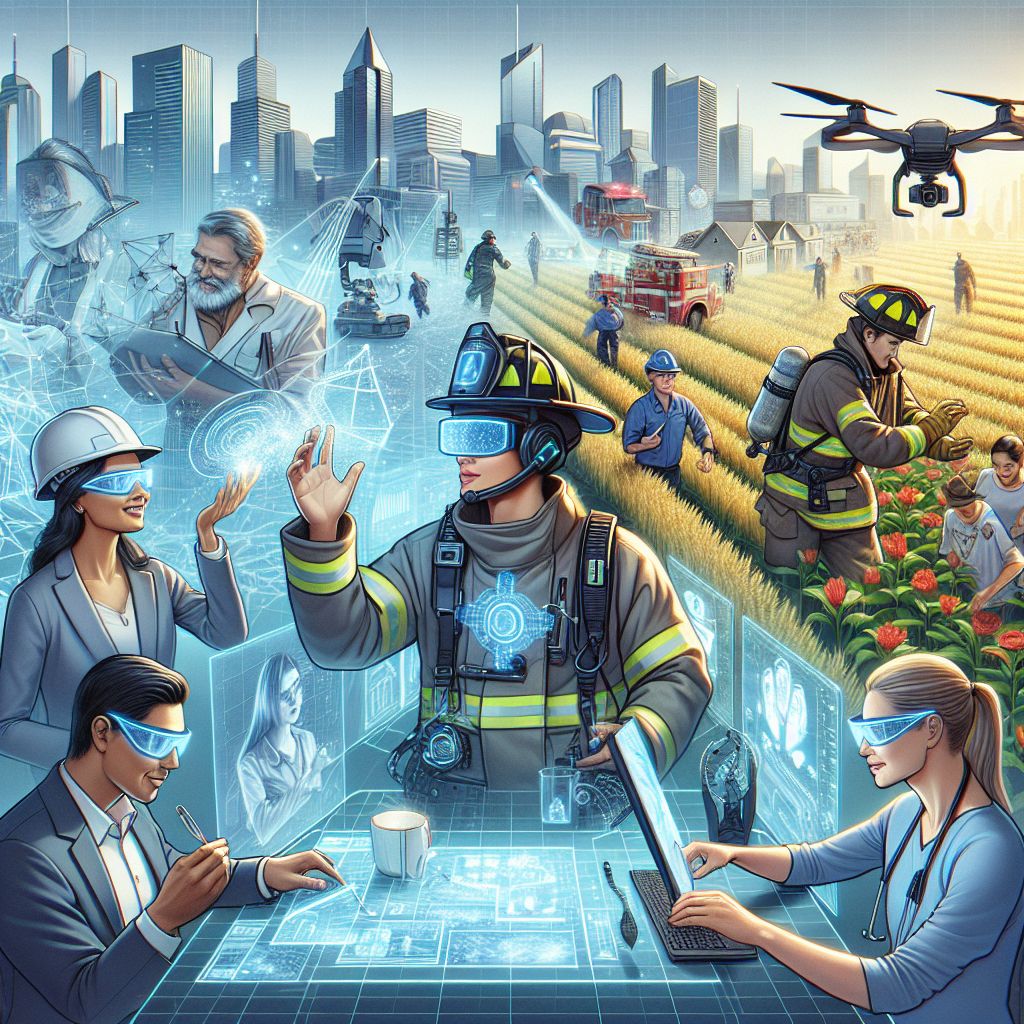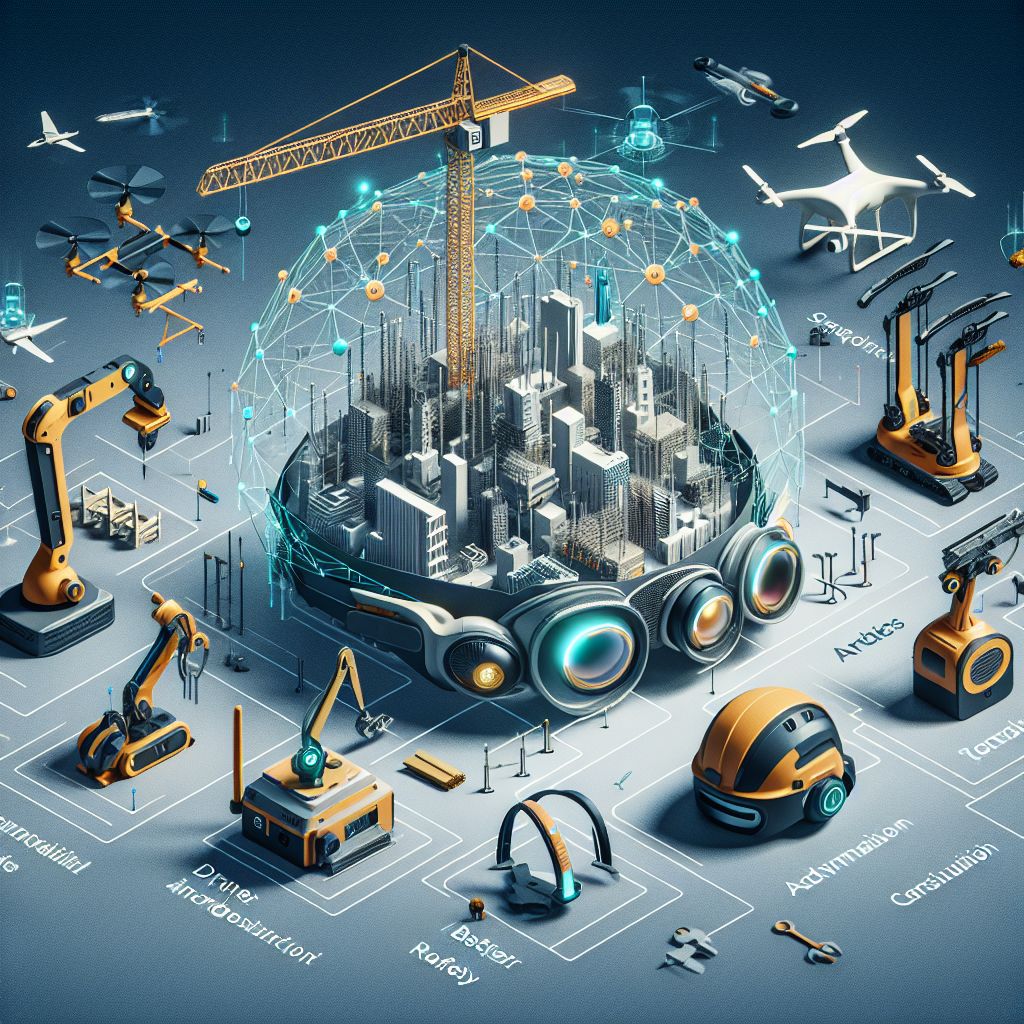Article-at-a-Glance
-
Discover the latest and most efficient power tools for construction in 2024.
-
Explore innovative software that’s changing the game in project management.
-
Learn about eco-friendly tools and practices for sustainable construction.
-
Understand the impact of AI and automation on the construction industry.
-
Find out how to choose the best tools and software for your construction needs.

Advanced Power Tools Redefining Construction Sites
Let’s talk power tools. They’re the muscle behind every construction project, and in 2024, they’re smarter and stronger than ever. We’re seeing tools that not only make the job faster but also safer and more precise. Imagine drills that communicate with your smartphone to ensure you’re using the right torque or saws that can cut through the toughest materials like they’re butter. Yes, these are the tools shaping the future of construction sites.
Innovative Software Enhancing Project Management
But it’s not just about the hardware. The real game-changer is the software that’s come to play. Project management platforms are now so intuitive, they feel like having an extra brain on the job site. They keep track of every detail, from scheduling to budgeting, and they’re accessible from the palm of your hand. This is about bringing every piece of the puzzle together seamlessly, so projects can be delivered on time, every time.
Eco-friendly Options for Sustainable Building Practices
Because the planet matters, we’ve got tools that work smarter and cleaner. Tools that are designed with the environment in mind, from solar-powered equipment to software that calculates the most efficient use of materials. This isn’t just good for the earth; it’s smart business too. Eco-friendly practices are becoming a competitive edge in the construction industry.
The Rise of AI and Automation in Construction
And let’s not forget the robots. AI and automation are not just buzzwords; they’re revolutionizing the way we build. We’re talking about drones that can survey a site in minutes, software that can predict project timelines, and robots that can lay bricks or tie rebar. This is the cutting-edge of construction, and it’s happening right now.
Essential Power Tools for Every Construction Professional
But before we dive into the specifics, let’s set the stage with the essential power tools that every construction professional should know about. These are the tools that are non-negotiable, the ones that you’ll reach for every day because they make your job possible.
Cordless Drills: More Power, Longer Battery Life
First up, cordless drills. They’ve been a staple for years, but the latest models are like superheroes. They’ve got more power, longer battery life, and features that protect both you and the tool. Look for brushless motors that offer better efficiency and smart sensors that prevent overheating.
Laser Levels: Precision and Efficiency in Layout Work
Next, laser levels. Accuracy is everything, and a good laser level can mean the difference between a job done right and a costly mistake. The new models are not only more precise, but they’re also easier to use. Some even sync with your smartphone to provide digital readouts.
Now, let’s talk about the saws. Reciprocating saws, to be exact. They’re the Swiss Army knives of saws, capable of making quick work of cutting tasks that used to take much longer. And with the latest advancements in blade technology and ergonomics, they’re better than ever.

Breakthrough Software Platforms Transforming Efficiency
On the software side of things, we’ve got platforms that are nothing short of revolutionary. These aren’t just tools; they’re complete ecosystems designed to make every phase of construction more efficient.
Project Management Tools: Streamlining Collaboration
Take project management tools, for example. They’re the backbone of any well-run project, ensuring that everyone from the architects to the subcontractors is on the same page. And the best part? They’re scalable, so they grow with your business.
The heart of modern construction planning is Building Information Modeling, or BIM software. It allows for the creation of detailed 3D models that can be used for everything from design to demolition. And with real-time collaboration features, it’s like having the whole team in one room, even if they’re across the country.
Don’t forget about mobile technology. With apps that give you remote access to blueprints and documents, you can make decisions on the fly without being tied to a desk. This is about freedom and flexibility, and it’s a game-changer for construction professionals.
Sustainability in Construction: Tools for a Greener World
Now, let’s talk about sustainability. It’s not just a buzzword; it’s a commitment to building in a way that respects the environment. And the tools and software available today make it easier than ever to meet that commitment.
Solar-Powered Equipment: Harnessing Natural Energy
Imagine using solar-powered equipment to do the same job as traditional tools but with zero emissions. That’s not a dream; it’s reality. And these tools are not only cleaner; they’re often just as powerful as their conventional counterparts.
Material Estimators: Reducing Waste with Precision
Then there are material estimators. These handy pieces of software help you calculate exactly how much material you’ll need for a job, which means less waste and more savings. It’s smart, it’s efficient, and it’s better for the planet.
Don’t overlook green building certification software. It helps you track your sustainability goals and can even give you an edge when bidding on jobs. Because today, being green can also mean making more green.

The Digital Revolution: AI and Robotics in Construction
We’re at the forefront of a digital revolution in construction. AI and robotics are more than just high-tech toys; they’re tools that can lead to serious efficiency gains and cost savings.
Automated Drones: Aerial Surveys and Inspections
Take automated drones, for example. They can do aerial surveys and inspections in a fraction of the time it would take a human team. And they collect data that’s more accurate, leading to better decisions and better outcomes.
3D Printing: On-site Production Capabilities
Then there’s 3D printing. We’re seeing on-site production capabilities that were unthinkable just a few years ago. Need a custom part? Print it right there and then. It’s that easy, and it’s revolutionizing the way we think about construction logistics.
Robotics: Automating Repetitive Tasks for Efficiency
And let’s not forget about robotics. These aren’t the clunky machines of the past; they’re sleek, smart, and incredibly capable. From laying bricks to tying rebar, they’re taking on the repetitive tasks that can slow down a project, freeing up human workers for more complex and creative work.
Elevating Trades Work with Smart Platforms
But technology isn’t just about the big, flashy stuff. It’s also about the smart platforms that elevate trades work to a new level.
Wearable Tech: Enhancing Safety and Productivity
Wearable tech, for instance, is enhancing safety and productivity on the job site. Smart helmets with heads-up displays, vests with built-in environmental sensors, and boots that can alert you if you’re in an unsafe area—these are the kinds of innovations that are changing the face of construction safety.
In-field Reporting Tools: Up-to-Date Insights on Progress
In-field reporting tools are another major advancement. They give you up-to-date insights on progress, so you can make informed decisions quickly. This means less downtime and more productivity, which is always good for the bottom line.
Collaboration platforms are keeping teams connected, no matter where they are. Real-time communication, file sharing, and project updates mean that everyone is always in the loop. This is how you keep a project moving forward smoothly.
All-in-One Marketing and Sales Platform: HighLevel 14 Day Free Trial
Finally, let’s talk about an all-in-one marketing and sales platform that’s perfect for construction professionals looking to grow their business. HighLevel offers a 14-day free trial, and it’s a platform that consolidates all of your marketing tools in one place. Elevate your marketing game with HighLevel. Start your free trial today and see how it can transform your marketing and sales strategy.

Choosing the Right Tools and Software
So, how do you choose the right tools and software for your construction needs? It’s all about assessing your business, comparing features, and taking advantage of free trials and demos.
Assessing Your Construction Business Needs
First, take a good look at your business. What are your biggest challenges? What are your goals? The right tools will address your specific needs and help you achieve your objectives. For a deeper understanding of how tools can meet your business’s demands, consider exploring construction trades office automation software solutions.
Comparing Features and User Reviews
Next, compare features and user reviews. What are other professionals in your field saying about the tools you’re considering? Look for honest feedback that can guide your decisions.
Taking Advantage of Free Trials and Demos
Most importantly, take advantage of free trials and demos. There’s no better way to know if a tool is right for you than to try it out in a real-world setting. And remember, HighLevel offers a 14-day free trial that you can start right now. Get your free trial and take the first step towards a more efficient and profitable construction business.
Now that we’ve covered the essential power tools and breakthrough software platforms, let’s delve into the specifics of mobile technology and its transformative role in construction.
Mobile Technology: Remote Access to Blueprints and Documents
Imagine being on the construction site and having instant access to every blueprint, every document, and every update. That’s the power of mobile technology. With just a few taps on a tablet or smartphone, you can view 3D models, check the latest project changes, and communicate with your team. It’s like having an office that fits in your pocket, and it’s absolutely essential for today’s fast-paced construction environment.
Sustainability in Construction: Tools for a Greener World
As we move forward, sustainability is not just a trend; it’s a necessity. The construction industry is stepping up, using tools that help build a greener world. Let’s explore how these tools are making an impact.
Solar-Powered Equipment: Harnessing Natural Energy
Power tools and machines that run on solar energy are no longer a thing of the future. They are here, and they’re powerful. Using solar-powered equipment means less reliance on fossil fuels, which leads to a significant reduction in carbon footprint. Plus, they’re cost-effective in the long run, harnessing the abundant energy of the sun.
Material Estimators: Reducing Waste with Precision
Over-ordering materials ‘just in case’ is a practice of the past. With advanced material estimators, you can calculate the exact amount needed for your projects, minimizing waste and saving money. This precision not only benefits your budget but also the environment by reducing the amount of unused materials that end up in landfills.
Green Building Certification Software: Tracking Sustainability Goals
Green building certification software is an invaluable tool for those aiming to meet specific environmental standards. It helps you track your progress towards sustainability goals, ensuring that your project complies with certifications like LEED or BREEAM. This software is a testament to your commitment to eco-friendly building practices, which can attract clients who value sustainability.

The Digital Revolution: AI and Robotics in Construction
The construction industry is undergoing a digital revolution, with AI and robotics at the forefront. These technologies are not just about innovation; they’re about addressing real-world challenges and driving the industry forward.
Automated Drones: Aerial Surveys and Inspections
Drones equipped with cameras and sensors can perform aerial surveys and inspections in a fraction of the time it would take a ground crew. They provide high-resolution images and data that can be used for mapping, monitoring construction progress, and inspecting hard-to-reach areas. This technology increases safety by reducing the need for manual inspections in dangerous or inaccessible locations.
3D printing is no longer confined to small-scale models. On construction sites, 3D printers are creating components on-demand, reducing the need for storage space and logistics. This on-site production capability means you can print anything from a custom pipe fitting to an entire wall panel, reducing lead times and transportation costs.
Robotics: Automating Repetitive Tasks for Efficiency
-
Bricklaying robots that can work tirelessly, laying bricks with precision and consistency.
-
Rebar-tying robots that speed up one of the most tedious and time-consuming tasks in construction.
-
Automated machines for tasks like painting or plastering, ensuring uniform quality and freeing up skilled workers for more complex tasks.
Robotics in construction is not about replacing humans; it’s about complementing their skills and allowing them to focus on areas where human touch and expertise are irreplaceable.
Elevating Trades Work with Smart Platforms
Integrating smart platforms into the trades is elevating the way work is done. From wearable tech to in-field reporting tools, these innovations are enhancing safety and productivity on the job site.

Wearable Tech: Enhancing Safety and Productivity
Wearable technology is transforming job site safety and efficiency. Smartwatches that monitor vital signs, helmets with augmented reality displays, and vests with environmental sensors are just a few examples of how wearable tech is making construction sites safer and workers more productive.
In-field Reporting Tools: Up-to-Date Insights on Progress
In-field reporting tools provide real-time insights into project progress, allowing for quick decision-making and adjustments. This immediacy ensures that any issues are addressed promptly, keeping projects on schedule and within budget.
Collaboration platforms are the glue that holds the project team together. They enable seamless communication and file sharing, ensuring that everyone, from the project manager to the newest apprentice, is in sync. With these platforms, teams can collaborate in real-time, no matter their location.
To sum up, the best construction tools and software platforms of 2024 are all about making your work smarter, safer, and more sustainable. Whether you’re looking to harness the power of AI, take advantage of mobile technology, or make your projects greener, there’s a tool out there that can help. And remember, the best way to find out if a tool or platform is right for you is to try it out for yourself. That’s why it’s worth taking advantage of free trials like the one offered by HighLevel. With a 14-day free trial, you can explore all the features and see how it can help your business thrive. Get your free trial today and start building smarter.
When it comes to empowering construction professionals with the right tools and software, the most critical step is to compare the features and user experiences of available options. This can make all the difference in ensuring that you select a product that not only meets your needs but also is reliable and user-friendly.
Comparing Features and User Reviews
For instance, consider the feedback on the latest cordless drill models: “The new X-Drill 2024 has drastically improved my crew’s efficiency with its extended battery life and powerful torque settings,” says Sarah from BuildRight Construction.
It’s not just about the specifications; it’s about how these tools perform in the field. User reviews can offer invaluable insights into how the tools hold up under real-world conditions, which is crucial for making an informed decision.
Another example is the comparison between project management software platforms. Users often highlight the importance of intuitive interfaces and robust customer support, which are essential for smooth operations. “After switching to ConstructoMax, we’ve noticed a significant improvement in our team’s productivity due to its user-friendly design and excellent support,” reports Mike, a project manager at SkyHigh Builders.
Therefore, it’s not just about the bells and whistles of a product; it’s about how it fits into the daily workflow of construction professionals and helps them achieve their goals.
Taking Advantage of Free Trials and Demos
The best way to know if a tool or software is the right fit for your business is to see it in action. That’s why taking advantage of free trials and demos is a smart move. It gives you a hands-on experience without any commitment, allowing you to test the features, gauge the learning curve, and determine the overall value it brings to your operations.
Navigating the Tools and Software Maze
In the ever-evolving landscape of construction technology, it’s natural to have questions. Let’s address some of the most common queries about the tools and software shaping the industry in 2024.

What are the major trends in construction tools for 2024?
The major trends include the integration of AI and machine learning for predictive analysis, increased use of mobile technology for on-site management, and a strong emphasis on sustainability with eco-friendly tools. These advancements are not just passing fads; they represent a shift towards more intelligent, efficient, and responsible construction practices.
“We’ve seen a 30% increase in project efficiency since incorporating AI-driven analytics into our workflow,” shares Alex, a site manager with GreenBuild Solutions.
These trends highlight the industry’s commitment to innovation and the constant pursuit of better, faster, and greener ways to build.
How can software platforms improve project management?
Software platforms can significantly improve project management by:
-
Centralizing information, making it easier to track project progress and manage resources.
-
Facilitating communication among team members, stakeholders, and clients.
-
Automating routine tasks, freeing up time for project managers to focus on strategic planning and problem-solving.
By leveraging these platforms, construction professionals can ensure that projects run smoothly from start to finish.
What should professionals consider when choosing construction software?
When selecting construction software, professionals should consider:
-
The specific needs of their projects and whether the software caters to those requirements.
-
The software’s ease of use and learning curve, as it should facilitate rather than hinder daily operations.
-
The level of customer support and training provided by the software company.
These factors will help ensure that the chosen software is a valuable asset to the construction process.
How do sustainability tools contribute to construction projects?
Sustainability tools contribute to construction projects by helping professionals design and build with environmental impact in mind. They enable the calculation of a project’s carbon footprint, optimize the use of resources, and ensure compliance with green building standards. As a result, these tools not only support eco-friendly practices but also can lead to cost savings and a stronger market reputation.
Can AI and robotics be cost-effective for small to mid-sized projects?
Yes, AI and robotics can be cost-effective for small to mid-sized projects. They offer scalable solutions that can be tailored to the project’s size and budget. For example, a small construction firm might use a semi-automated bricklaying machine to increase productivity without the overhead of a fully automated system. By adopting these technologies strategically, smaller projects can reap the benefits of innovation without excessive investment.
In conclusion, the best construction tools and software platforms of 2024 are about empowering professionals with efficiency, precision, and sustainability. From advanced power tools that streamline tasks to software that facilitates seamless project management, these innovations are setting new standards in the construction industry. And with the rise of AI and automation, the future looks even brighter for those who embrace these technologies.
Remember, the key to successfully integrating these tools into your work is to stay informed, be open to change, and always look for ways to improve your processes. By doing so, you’ll not only stay ahead of the curve but also deliver better results for your clients and your business. So, don’t hesitate to explore new options, and make sure to take advantage of opportunities like the HighLevel 14-day free trial to see firsthand how the right platform can make a difference in your construction projects. Start your free trial now and join the ranks of construction professionals who are building smarter, faster, and greener.
